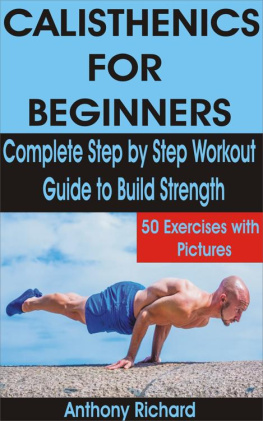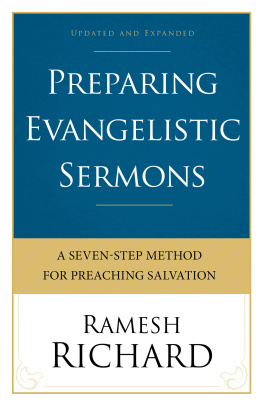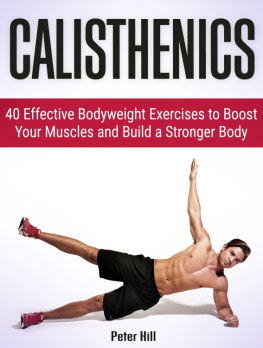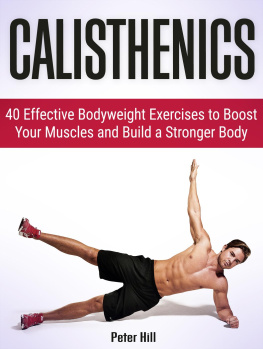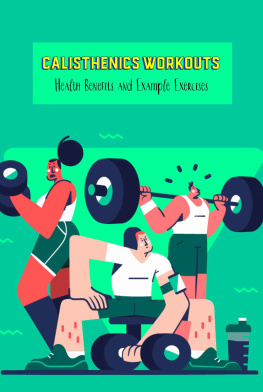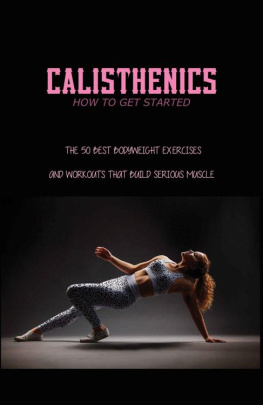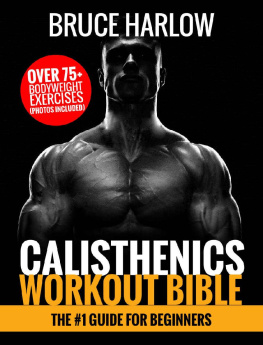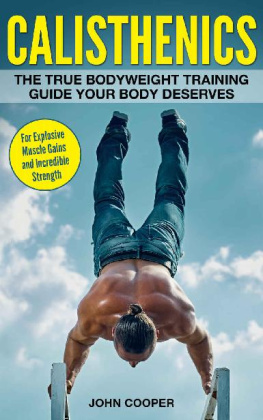CALISTHENICS FOR BEGINNERS
Complete Step by Step Workout Guide to Build Strength with 50 Exercises and Pictures
By
Anthony Richard
Copyright@2020
Contents
Chapter 1
Calisthenics
What comes to your mind when you think of calisthenics?
It can be defined as a form of training involving the use of bodyweight exercises to help build the body muscles. It includes practices such as push-ups, dips, pull-ups, or even pistol squats. It is usually associated with agile and lean athletes and involves mastering your body and developing body balance, control, strength, flexibility, coordination, mobility etc. And it is usually drafted with the athlete's work-out plans.
In simple terms, calisthenics is a form of art which involves using the body weight to use human power as well as athletic ability to its maximum potential. It helps to master control over moving or lifting your body in space. Its a long-practised art and has the name coined from two Greekwords; kallos , meaning beauty and sthenos , which means strength.
Recently the practice has taken on a new flavour in the form of Competitive Calisthenics; also called street sport or street work-out. This form has seen international light in the form of acrobatics, dance and gymnastics.
The beautiful thing is the fact that it is the most straightforward type of exercise, and does not require fancy instruments.
How calisthenics works
The art of calisthenics involves a gradual transformation of the entire body, physically, emotionally. It is the use of the whole body without emphasizing any muscle over the others. It provides you with a surge of strength from your fingertips down to the bottom of your feet. It is all about the movement of the body in space; hence it is the highest form of "functional movement training". Now functional movement training can be defined as the art of training in such a way that will enhance the method you use for your day to day life tasks directly; it can also be defined as a specific physical requirement needed for your sport or work.
To do this effectively there are some hacks; for instance, it is advisable you make use of elevated surfaces for changing the exercise angles, as well as to increase the percentage of your body weight as you lift it. Also, you can make use of walls and poles (vertical surfaces) to give your body new challenges to overcome and hence build your core.
Chapter 2
What calisthenics can do for you?
These are the things calisthenics can do for you
It increases the strength of the body and provides endurance:
The course of training, the bodyweight is used to exercise specific muscles of the body. In exchange, the tissue becomes more robust and well able to carry your body weight, this is because it is a form of resistance training and as such helps increase the average expenditure of energy. It helps to build body endurance which allows you to hold certain positions for a more extended period and also to perform more reps or sets.
It strengthens mental health :
Another enjoyable truth about calisthenics is the fact that it not only benefits the athlete's body but also benefits the mind; this is because the knowledge of your body's capability leads to proper enlightenment as well as help boost your confidence. It also helps to reduce depression symptoms as it gives the mind something to do hence uplifting ones mood. And then there's also the fact that Calisthenics work-out helps to release endorphins an excitement hormone which relieves stress and tension.
It helps to improve the biomechanics of the body :
Calisthenics helps to improve body balance and coordination. It aids the development of the body all-round, including your body posture. Hence it aids motor coordination and also body balance.
It is easily affordable:
Yes, that's right, calisthenics is a very affordable form of art as it does not require the use of any expensive machinery; it just needs your body and a suitable place to carry out your exercises. You also do not need a gym membership to carry out Calisthenics training; you just need a playground (can also be in the corner of your house), a mat, pull-up bar and gloves (optional).
It is a complete body work-out :
Nearly all Calisthenics training requires a lot of muscles, whether pull-ups which require your arms, core, back, shoulders and chest. This way, you target more muscles (about 2-3 times) than when using machines in the gym.
Can be performed everywhere :
This is another lovely point to note about calisthenics, the world becomes your gym. You can train anywhere as long as you have enough space to carry out the exercises easily. This way, you don't have to worry about getting up early in the morning to go to a gym to carry out your training exercises.
Chapter 3
Preparing for calisthenics exercise
Before beginning your calisthenics work-out, it is essential to prepare first by warming up. A warm-up helps to prepare the body for the work-out exercises as it loosens the joints of the body; it also helps to increase the flow of blood to your muscles. These actions prepare your muscles and also help to prevent injury during workout.
So in this chapter we will be looking at routines to follow for effective warm-up before your exercise.
- Rope jumping: you could attempt this by doing your regular rope jump and then alternating between your legs, knees,
- Running on a spot or around can help too.
- Swinging your arms round in circles, you can swing both arms at the same time or separately.
- Scapula Pulses: to do this stand straight with arms stretched out perpendicular to your body, taking a T-form, and then slowly move your arms back and forth.
- Forward and Backward Scapula Swing: placing your elbows together in front of you, touch your shoulders with your hands and slowly draw circles while retracting your scapula forward and backwards.
- Scapula Push-up/Pull-up: Either of them is done depending on if you want to do push-ups or pull-ups. Now for this, you should get into a push-up/pull up position, keeping your arms straight and retracting just your scapula.
- Shoulder Dislocation: for this, you need a resistance band. Stretch the band between your arms while keeping your arms straight. Next, transfer your hands to your back passing over your head all the way down to below your bum.
- Pulling Band Apart: Still using the resistance band, hold both ends in each hand, push out your chest and retract your scapula. Then place your arms in front of your body and then pull the resistance band apart and towards your chest.
- Wrist Stretch: put your hands forward with your arms straight while sitting on your knees, next move your hips in a back and forth sync.
- Shoulders Openers: Place your knees on the floor and raise your bum by 90 angle. Next place your arms forward stretching it away from your head and then keep your head as close as possible to the ground.
For your warm-up routine to be effective, ensure you maintain these positions for as long as you can, using a timer to see how your endurance level is.
Chapter 4
Advice on reps, sets and rest on calisthenics
The process of becoming an expert in the world of fitness can be tasking, it is one that demands an enormous amount of time, and it can also drain one. There's need to understand the concepts associated with fitness that is considered to be most valuable. In the field of fitness, the key concepts that you should look out for are,

